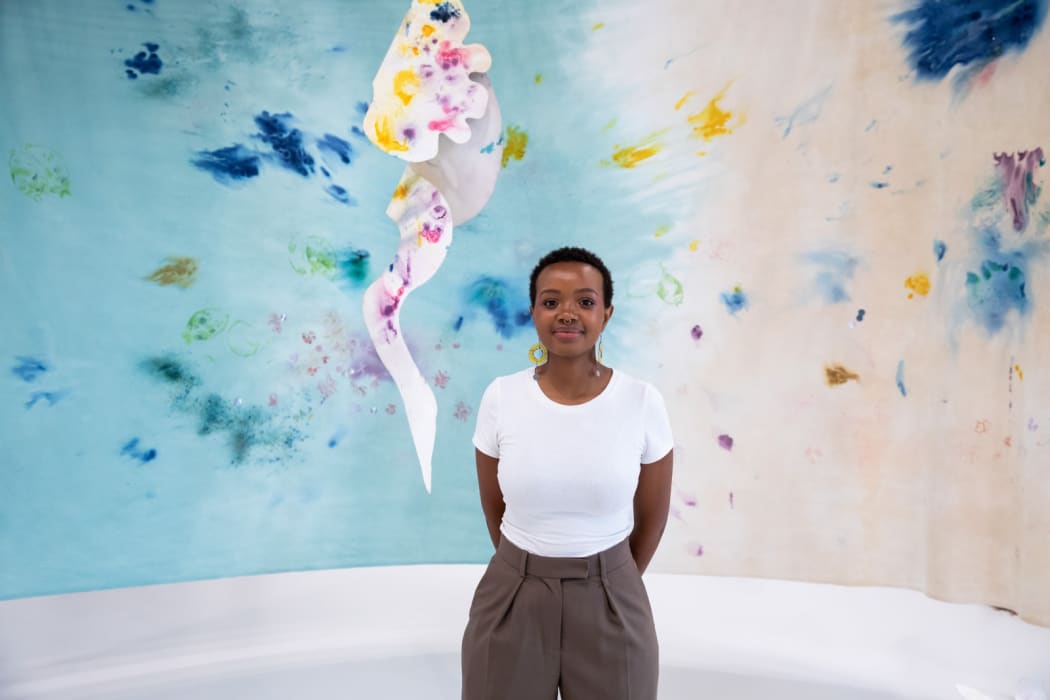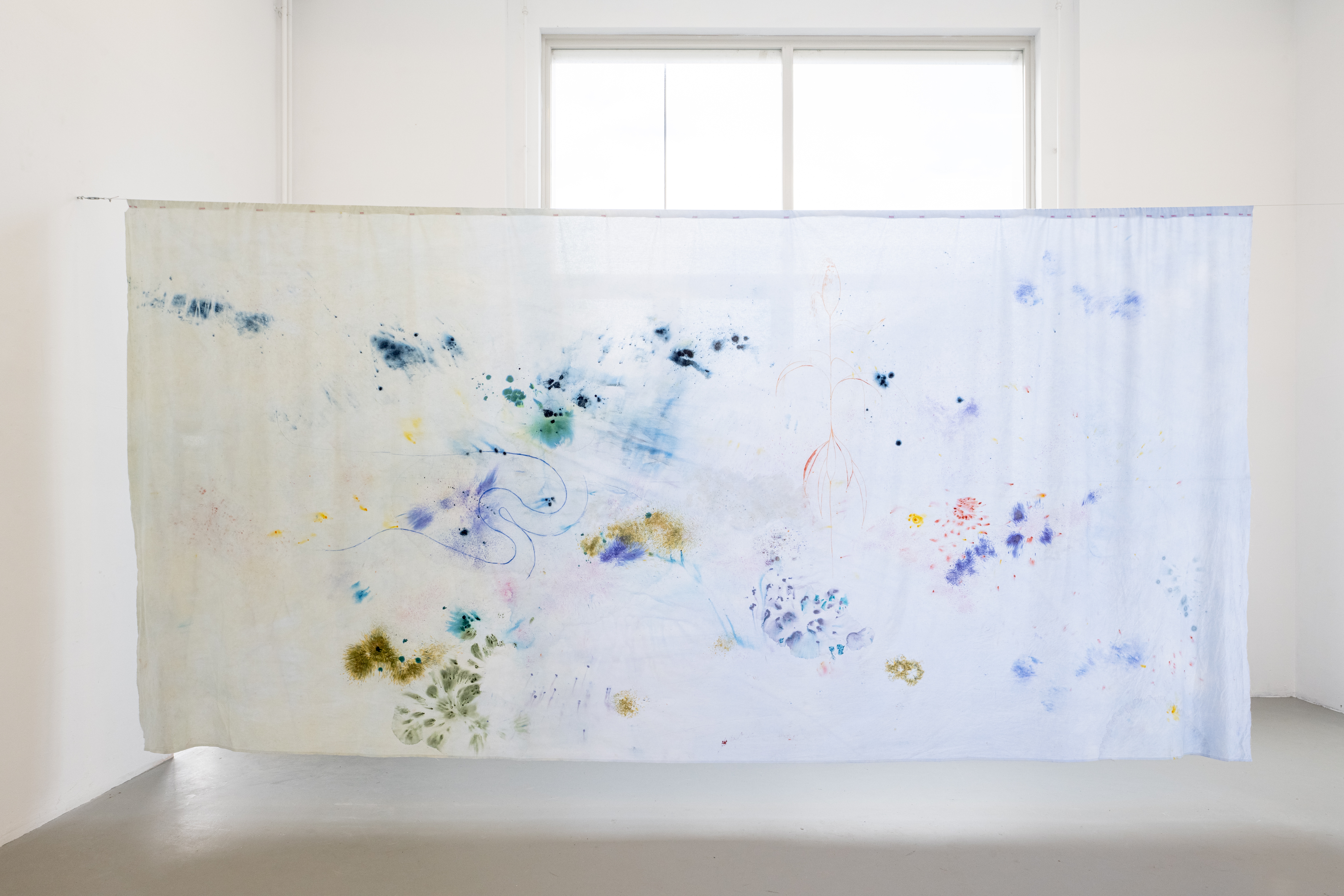
© Portrait Image of Agnes Waruguru; Image: Fleur Beerthuis
Your practice involves mixing materials, often non-traditional ones. How does the process of material selection go about for you?
I guess it depends. I would say that earlier, before this residency, all my work would start based on material and then become a work. This current work with embroidery which will be included in the show in Havana later in the year is part of a larger piece but was cut out. I love to reuse things that already have a life or a purpose. I like to use things from my everyday life, like the blueberries in that work: It starts from a very basic point, where I was eating blueberries for two weeks straight, and I thought “Well I have so much, let me see what I can do with it.” Because I was already using a lot of flowers, not just to make the color but also the print on the painting, it’s a material I already had and was interacting with. I was also interested in the fact that I was using it in different stages, like smashing it into paper, into the textile, and seeing what it leaves behind. Also when I’m rubbing the skin I can’t really predict the shape it’s going to take or even the color that it’s going to give. So, it's also a happy surprise for me. It’s an exciting way of making a new mark.
Can you tell me a little bit about your mark-making process? The relationship between material application and representation and how they may relate?
I think I’m not that interested in representation, to be honest. I think it’s more about trying to give myself back a feeling. It starts with a feeling which is usually somewhat abstract and then trying to connect the feeling to a place or time. That’s how a specific motif comes around. It's also a natural inclination to a specific motif like with these embroideries, I think the first part started when I was living around palm trees and I was always trying to abstract these palm trees while also thinking about why are there palm trees in the coast but also in Nairobi and it turns out there is a whole colonial history behind it. It kind of starts with a random event and then to keep following curiosity and keep giving it back to myself to eventually make it my own language. For example, with this blue piece for Havan, it makes me think of all these different types of twilights, all these different blues just before the night. First, it's giving myself the color and the mood of that place and then adding different things from the initial mark-making that happens. So, it’s a process of being in collaboration with the work- what is it showing me? There are a lot of layers that occur like in this piece: washing the paper, applying ink, then applying other pieces that I worked on to make a print of each other. So in this, you see these leaf-like creatures which are in a work that is in a museum now. So, it’s like the pieces have relatives all over, communicating with each other. Both make a print of each other; giving each other color. Its playful and completely unpredictable.

There is a reference to the domestic, nature, and time in your practice. How did these themes come into your work?
I think it comes from feeling displaced. I moved out of home when I was 15. I’m quite sensitive to what’s around me in a way that I really take it in and embody it. I become very invested in what I’m feeling from my surrounding. So, I started using my practice to ground myself and remind myself why I’m here, and why is my experience different from other people's. Kind of like looking for myself in the pieces or making space for myself. I would say that moving to the States and being the only Black person in my painting class, not just even Black but African, you have to communicate so much of who you are and why you are there that it’s just what I started doing. Trying to answer these questions, trying to preserve my personal history. Represent the people that I’m familiar with as well.
Many female artists are drawn to mediums that have a direct reference to what is viewed as traditionally female endeavors, for example, textile and needlework, How do you view these in a contemporary setting? How do you as a young artist relate those materials to the current time?
I think this debate of “craft” vs art, at the end of the day, doesn’t really matter. I think now there are a lot of people working with embroidery and traditional dyeing, learning by being together with people as well which is why I gravitated to this mode of making. It was an education in a non-institutional way. By doing the action, it gave me a lot of time with my mother and grandmother. We would tell a lot of stories while we were doing these things which gave me a lot of knowledge and information which I wouldn’t have if I hadn’t given the time to engage in these practices. I think it’s also a way of denying western art history. I had the struggle when I went to school in the States, I didn’t know any of the artists that they were referencing. I was like, “Does this mean I don’t know anything?” But I have this wealth of knowledge of weaving, dyeing, even cooking, repetitive actions. Sweeping. These things that have really educated my way of making in the studio. I think they also tell a really long story about people, migration, objects, etc.

© Agnes Waruguru, I flew and swam and travelled through time, Mixed media on cotton, 2022; Image: Sander Van Wettum
That’s an interesting way to put it. The narrative, the stories, and time and what you were mentioning about identity and displacement so creating these pieces allows you to put all these concepts together which is super nice. Not only do you use many different materials, but you also approach different mediums like painting, installation, and photography. How do you go about deciding how a project will manifest?
I think it tells me what it wants, actually. I do draw all the time. I draw consistently. I think that’s the base of my practice, through drawing. But sometimes I’ll try to make something into a painting, and it’ll tell me, “No, I’m not a painting.” It’s supposed to be something else. It also tells me what it needs to be. I’ve never worked with sound before but I’m collecting sounds to make a sound piece to create a soundscape that holds space for a painting. So, its expanding, and all these things can exist together.
That’s exciting.
Yeah, I’m actually super excited about it. I’m interested to see where it goes.
Do you have a preference for a medium above the rest or is drawing it?
I think I really am a painter. If I were to be asked, “What are you?” I think I’m an Artist but I think I approach other things the way I would approach a painting, the thinking of painting. I like this trance state that goes into a painting because you’re in your body and not in your head.
Speaking of identity and place, how is the residency going?
The residency is good. It’s already a year now so this will be the second year. It took me a while to adjust to the Netherlands and this colonial history. This summer I went home and I went to visit my grandmother and her farm was completely dry and I have never seen this in my life. It’s crazy because we always talk about climate change and sustainability, all these things. And living in Europe and seeing this ideal environment but where actually all the problems are coming from. The Netherlands is actually quite notorious for this. So seeing the effects on someone like my grandmother, all she does is take care of her farm. Everything she consumes is either from her neighbor or from her own farm. She doesn’t travel much. She has a very simple, what they call “sustainable” life, yet she’s the one that has to suffer the consequences. I’m always trying to reconcile these things.
Yes, it’s completely understandable. How do you see these things affecting your practice? Do you have any ideas of what comes next?
Yes, I’ve been thinking a lot about this idea of place and maybe radical imagination of trying to build a closeness to land and elements. They are living things as well and I’m figuring out how to communicate this closeness and care. Maybe it’s a shifting attitude to how I’m living everyday life. How we can live with the earth and not “in it”. I think that’s how I’m thinking about it. With this soundscape, for example, I really like making objects but I’m also at a place where there's a lot of making happening around me and I'm wondering what is the least intervention I can do while still satisfying my need for material production or putting things together, you know?
As a final question, Inspiration is a complicated word but what things do you take in and apply to your work, things that you love doing or looking at that inspire you in some way?
I love being outside. Since moving to the Netherlands, I take a walk every day. I like to spend time outside. That makes me feel really energized. I love to read as well. I read a lot of African literature, a lot of fiction. I really love stories. I love to listen to science podcasts, as well.
I was watching Cosmos yesterday, so I get you.
Yeah, that’s it. I also try to spend a lot of time relaxing and seeing what happens.
